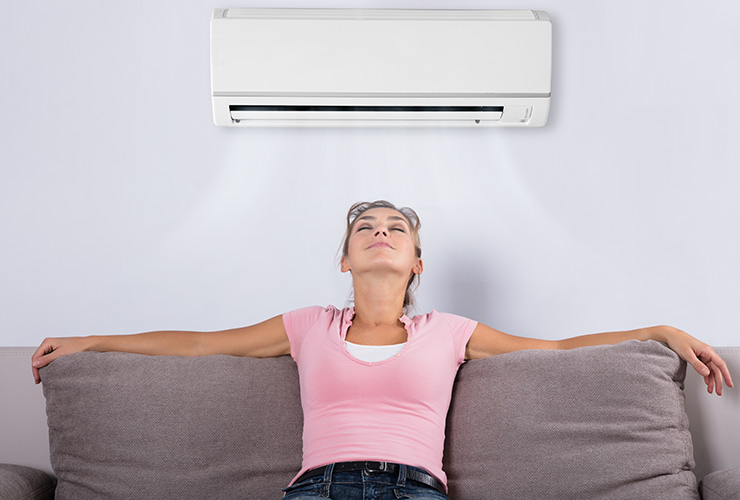Fast read
Air conditioners, commonly used in Australian homes, account for nearly 40% of household energy consumption. Their electricity usage varies based on type: home units consume about 3,000 watts hourly; portable units can use up to 4,100 watts hourly, and window units can use up to 1,500 watts hourly.
Energy consumption is influenced by factors including unit size, space to be cooled/heated, Energy Efficiency Ratio (EER), and Seasonal Energy Efficiency Ratio (SEER). Higher EERs and SEERs indicate more efficient energy consumption. Using fans can save energy as they use substantially less electricity than air conditioners.
Other influencers include the set temperature, duration of use, energy rating of the unit, and direct sunlight exposure. Efficient usage and understanding these factors can help reduce electricity bills.
Do air conditioners use a lot of electricity?
In Australia, many households turn on the air conditioner because it’s burning hot outside. However, many Australians never take the time to consider how much electricity an air conditioner uses and what this costs them per hour or day.
Since there is a range of different air conditioners on the market, the answer will vary from household to household. In saying this, almost 40% of Australians’ household energy consumption goes towards heating and cooling. So, while determining exactly how much energy they use specifically is difficult, averages and what affects the consumption can still be explored to determine how much energy you need to budget.
So, what’s the electricity use of different air conditioner types?
Since there are several different aircon models, there are also several consumption numbers.
- Home air conditioners use around 3,000 watts of electricity each hour. If you run the air conditioner 24/7, you consume 72,000 watts daily on air conditioning alone. If your air conditioner offers a fan-only mode, switching to this will decrease the consumption to about 750 watts an hour.
- Portable air conditioners consume up to 4,100 watts an hour
- Window air conditioners can use up to 1,500 watts an hour
These numbers are just averages, and the specific consumption of your air conditioner will be identified on the manufacturer’s label.
Factors that can influence
A number of different factors can also affect the amount of electricity that your air conditioner uses. The first and most obvious factor is the size of the air conditioning unit. The size of the unit along with the space that it needs to cool/heat will significantly affect energy consumption.
For example, a 500-square-metre home will require less energy to cool/heat than a 1,000-square-metre home, which is basic knowledge. Another factor that affects the amount of energy consumed is the EER and SEER ratings.
The energy efficiency and seasonal energy efficiency ratios can dramatically impact energy efficiency. As the name suggests, units with higher EERs and SEERs will consume less energy per hour. Fan mode is another method of reducing energy consumption that not many consider.
Even when air conditioners are in the lowest setting, they still use a lot of electricity. An extremely common way to reduce energy consumption is by using a fan. Fans use almost nine times less electricity than an air conditioner, which means the spinning blade can sometimes be a better option when you are lying in bed. Nevertheless, air conditioners provide numerous benefits that fans cannot, such as reducing moisture in large rooms and keeping an entire room cooled for longer periods.

Furthermore, analysing your electricity bill and its potential fluctuations over time is another way to gauge how much electricity your air conditioner uses. The following factors can influence your electricity bill.
Temperature
The temperature and the duration the system runs determine the number of watts the system uses. Moreover, you shouldn’t set the system’s temperature more than 8 degrees below the ambient temperature. The air conditioning cost can increase by 8-12% for every degree you adjust the thermostat.
Time running
You shouldn’t leave the system on continuously, as it uses more watts over extended periods. Turn it off in the evening or before bed and open the windows for fresh air. After turning off the air conditioner in winter, keep the windows closed to retain warmth longer.
Energy rating
As previously stated, purchasing an air conditioner with a higher Energy Star rating will consume fewer watts. As a result, the system will use less power, and the electric bill will be reduced. If the present system is known to have lower efficiency ratings, it is advised that an update be undertaken if the opportunity arises. Installing a new, more efficient system will be less expensive in the long run than preserving the old, inefficient one.
Sunlight
When the room is excessively hot, or the air conditioning system is exposed to direct sunlight, it must work more. As a result, the air conditioner will have to work more to keep the area cold, consuming more power. Close the windows, close the blinds/curtains, and keep the system out of direct sunlight to solve this problem.
So how much electricity does an air conditioner use?
Understanding the electricity consumption of air conditioners is crucial for Australian households aiming to manage energy costs effectively. With nearly 40% of household energy consumption dedicated to heating and cooling systems, it’s essential to be aware of the electricity usage of different air conditioner types. Home air conditioners, for instance, use around 3,000 watts per hour, while portable and window units can vary in their consumption.
Several factors influence the electricity use of an air conditioner, such as the unit’s size, EER and SEER ratings, and the use of fan-only modes. Opting for energy-efficient models with higher ratings can significantly reduce electricity bills over time. Additionally, simple habits like adjusting the thermostat sensibly, limiting continuous usage, and managing sunlight exposure can further decrease energy consumption and costs.



